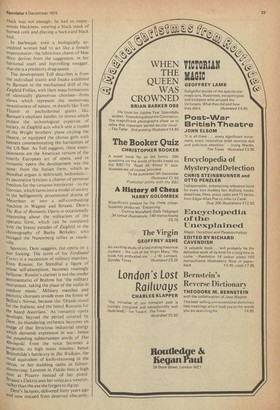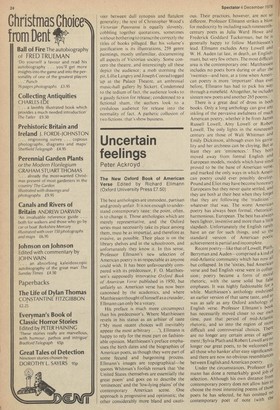The roar of the grease paint
Peter Conrad
On With the Show!: The First Century of Show Business in America Robert C. Toll (Oxford University Press £12.50) The Rise of Romantic Opera Edward J. Dent Edited by Winton Dean (Cambridge University Press £6.50) Victorian Panorama: Paintings of Victorian Life Christopher Wood (Faber £12.50) Entertainment is an American invention. Lawrence's Americans in The Phoned Serpent rush to the bullfight because it offers the opportunity to gape at a life they are incapable of living. The Mexicans. as Lawrence points out, have no notion of theatre: the routine of their existence is a ritual, but intruding Americans imagine a ceremonial like the snake dance to be a show, a rehearsed and merchanised thrill. Entertainment is the invention of a people which has renounced the capacity to make enjoyment for itself, and segregates a specialised caste of acrobats and jokers charged with the duty of amusing it. Show business is a symptom of the American demand for mechanical mediation, for transforming the casual succession of life into the crafty, automated premeditation of art. Instead of conversation, America has televised talk shows: the insidious flicker of the cathode tube and its inane eventfulness become a substitute for consciousness. Instead of climate, chronology and history, America has weather reports, time checks and news flashes.
Art mechanises life: this is why American entertainment considers itself an industry, and Robert Toll in his raucously enthusiastic On With the Show! treats it as such. Barnum, the circus magnate, appears as a heroic profiteer, as magnificently fraudulent with his humbugging hoaxes and publicity stunts as his economic relatives, Dickens's Merdle or Trollope's Melmotte. who conjure, like Barnum, with illusory quantities and bewitching false promises. Al Jolson regarded himself as a 'salesman of songs and jokes': gags were his wares, and he learned to vend them during an apprenticeship in 'small stores. . . called vaudeville.' Entertainment offers models of the economic and technical structures of society: it shows machines at play. The
circus, Toll suggests, encouragingly corn' bined 'the efficient ... planning and specialisation of the factory with the co-ordinated efforts of different people working together for a common goal.' Houdini's escapes from manacles, straitjackets and a torture chamber of imprisoning gadgets were a training for survival in an intimidatinglY technological society, just as the lion' taming and bronco-busting of Barnum's circus artists had been parables of survival against the natural odds of the wilderness. Even the strip-teaser, Carrie Finnell, when her million dollar legs became too slack and flabby to exhibit, took to tassel-swirling and transformed her body into an engine of astonishing dexterity: she could swirl tassels attached to her breasts using only the pectoral muscles, make left and right tassels swirl in opposite directions, and even counterpoint this by spinning other tassels from her buttocks, like some spangled dervish.
Because entertainment is, as Lawrence saw, a substitute for existence, its business is impersonation. An inert audience paYs to see life being lived and enjoyed on it5 behalf. However, the actors are not jovial life-spirits but sad, empty fictions who in their turn plead with the audience to make them real by believing in them. The actors. as much as the audience, are prevented from living: they can only imitate life. Even a black comedian had to act like a blacked-UP, minstrel: for the sad Bert Williams, one 01 Toll's most interesting characters, being
black was not enough: he had to impersonate blackness, wearing a black mask of burned cork and playing a backward black fool.
In burlesque, even a biologically accredited woman had to act like a female impersonator: the lubricious charm of Mae West derives from the suggestion, in her baritonal snarl and hip-rolling swagger, that she is a predatory drag-queen.
The development Toll describes is from the individual stunts and freaks exhibited by Barnum to the mechanised drill of the Ziegfeld Follies, with their mass formations of identically glamorous chorines—from Shows which represent the monstrous Inventiveness of nature, in dwarfs like Toni Thumb or pachydermal giants like Barnum's elephant Jumbo, to shows which Imitate the technological expertise of society, in Ziegfeld acts which sent a model of the Wright brothers' plane circling the theatre, or equipped the chorus girls with helmets commemorating the battleships of the US fleet. As Toll suggests, these enter tainments are the American version of the courtly European art of opera, and in romantic opera the development was the same: from the Italian form, which as Stendhal argues is deliriously hedonistic-its decorative lyricism a charter of personal freedom for the virtuoso interpreterto the German, which turns into a model of society In the belligerently processional drama of Meyerbeer or into a self-combusting Machine in Wagner and Strauss. Dent's The Rise of Romantic Opera is occasionally interesting about the militarism of the oPeratic form, which can be compared With the brassy parades of Ziegfeld or the Choreography of Busby Berkeley, who restaged the Nuremberg rallies as vaudeville.
Spontini, Dent suggests, put opera on a War footing. The score of his Ferdinand Cortez is a succession of military marches.
Even Rossini, for Stendhal a figure of otiose self-absorption, becomes rousingly bellicose: Rossini's clarinet is not the tender
sentimentalist of Brahms but 'the military instrument, taking the place of the violin in
outdoor music.' Military marches and Patriotic choruses invade even the forest of Bellini's Norma, because the 'Druids stood for the Italians, and the hated Romans for the hated Austrians.' As romantic opera develops, beyond the period covered by Pent, its thundering orchestra becomes an
Image of that ferocious industrial energy Which demands expression in war: hence
the pounding subterranean anvils of Das
nheingo/d. Even the voice becomes a Projectile, its high notes missiles: hence iihinnhilde's battle-cry in Die Walk/ire, the v°cal equivalent of knife-throwing in the circus, or her stabbing oaths in Glitter dointnerung. Leonore in Fidelio fires a high n°te at Pizarro instead of her pistol. Strauss's Elektra uses her voice as a weapon, rather than the axe she forgets to dig up.
Dent's lectures, delivered forty years ago and now rescued from deserved obscurity,
veer between dull synopsis and flatulent generality; the text of Christopher Wood's Victorian Panorama is equally slovenly, cobbling together quotations, sometimes without bothering to transcribe correctly the titles of books pillaged. But his volume's justification is its illustrations, 259 genre paintings, mostly unfamiliar, documenting all aspects of Victorian society. Some concern the theatre, and interestingly all these depict the audience; a mob storming the pit, Lillie Langtry and Joseph Conrad togged 'up at the Palace Theatre, an ambrosial music-hall gallery by Sickert. Condemned to the tedium of fact, the audience looks to a gaudy fiction for release; condemned to a fictional sham, the authors look to a credulous audience for release into the normality of fact. A pathetic collusion of two fictions : that's show business.








































 Previous page
Previous page